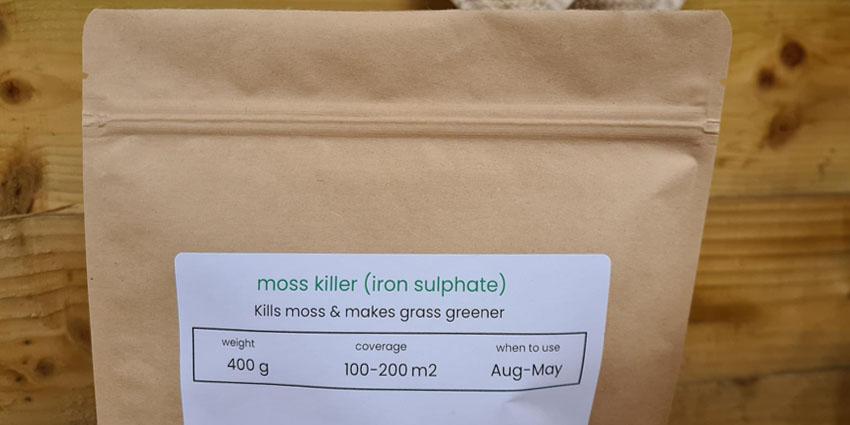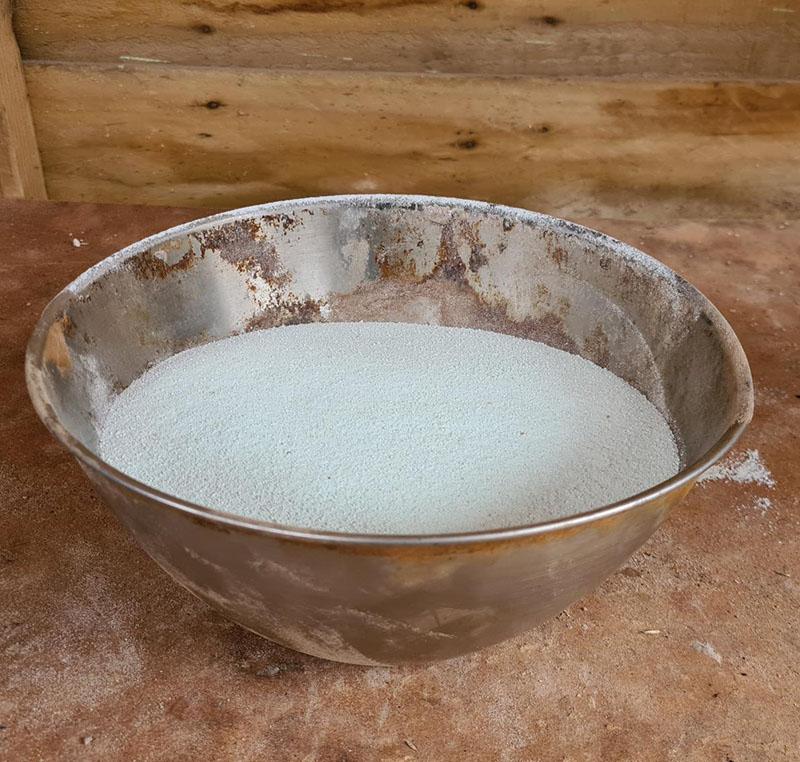
Created By
Matt Adams
Updated On
- March 1, 2024
Get FREE Exclusive Access
Keep your lawn pristine with exclusive tips, offers and insights that I only share with my private subscribers.
Latest Posts
Iron Sulphate for lawns – How, why & When to use it as a moss killer
- By Matt Adams
- March 1, 2024
Jump to
Get FREE Exclusive Access
Keep your lawn pristine with exclusive tips, offers and insights that I only share with my private subscribers.
Iron sulphate is a widely used product on lawns. It is, of course, known for its strength in controlling or killing moss. That’s not all though, it can also help grass with photosynthesis, meaning it will help give it a nice green colour while adding some much-needed nutrients into the soil.
While it’s a widely used product, there are some precautions to take when using it on your lawn at home. Not least, using the correct amount in the correct form.
It’s also important to know which products can and can’t be used alongside it. Or knowing how long to wait after overseeding before using iron sulphate.
So, here I’m going to explain how to apply it, why use it and when is best to use it. I’ll also give you the ways in which it can be applied over the course of a year. Meaning if you have a recurring moss problem, you can combat it once and for all.
First let’s look at what exactly iron sulphate is.
What is Iron Sulphate and why is it so popular?
Iron Sulphate is:
- A chemical element in the periodic table with the periodic formula Fe
- Essentially a salt which is also sometimes called a trace element
- Bought in different forms such as a soluble powder, granules mixed with sand, or granules mixed with fertiliser (more on this below)
- Often known as ferrous sulphate of iron.
- A kind of light green colour when bought as a soluble powder
You should use it to:
- Green-up the grass blades
- Kill moss and give the grass a boost
- Add nutrients back into the soil during or following the winter
Remember though, iron sulphate won’t kill off weeds because it’s not a herbicide. So, now let’s look at the different forms in a bit more detail.
What are the different forms in which it can be applied to your lawn?
It can be bought in different forms. The main ones are soluble powder, a granular form mixed with sand or a granular form mixed with fertiliser.
You can identify packaging for each product type based the description, for example:
- Water Soluble Pure Iron Sulphate (applied at 4g per m2)
- Lawn Sand + x% Fe (applied at 70g per m2)
- Lawn Fertiliser + x% Fe (applied at 30g per m2)
You would never just apply pure granular iron sulphate to your grass. It always needs to be mixed with something before using it.
The way to identify if a fertiliser or sand contains iron is to look at the product analysis.
It will usually say e.g. +3% Fe because Fe is the periodic formula for iron.
There are different requirements in terms of application rates and usage frequency for each of the above products.
I’ll also recommend how you can use all three products together to achieve ultimate moss control.

When and how often to apply iron sulphate to your lawn
There are 2 main reasons for using iron sulphate on your lawn and depending on your need will determine how often to use it.
- A one-off to add extra nutrients
The first one is simple, if you’re just wanting to add some extra nutrients, then I’d recommend simply using a Winter fertiliser that contains iron. For example our Specialist Winter Fertiliser does just that.
If you want to go a step further, then use the soluble iron once in late Winter and once in early Autumn at 2-4g per m2 – more on application rates below.
- Part of a programme to control, remove or kill moss
If you’re looking to control, kill or contain moss, then here’s what I’d recommend. Apply an iron based product a bit more frequently like once every couple of months.
Here’s what your yearly programme might look like:
- Late Winter – Apply soluble moss killer at 4g per m2 mixed with water
- End of April – Apply Lawn Sand +Fe at 70g per m2
- End of June – Apply Lawn Sand +Fe at 70g per m2
- End of August – Apply Lawn Sand +Fe at 70g per m2
- Early Autumn – Apply soluble moss killer at 4g per m2 mixed with water
- Mid Winter – Apply Fertiliser mixed with Fe (Our specialist Winter Lawn Feed)
Note though, the above timeline is a full on moss control programme and you shouldn’t need to do it every year but if you do it for a year, then you should see a massive difference the following Spring.
Also remember, that Lawn Sand +Fe is not a replacement for your seasonal fertiliser or lawn feed, so you’ll still need to do your Spring & Summer Feeds using our Signature Feed
One more thing, be careful when applying lawn sand +Fe in hot weather. It improves drainage, so if there’s not much water coming, you may want to hold off using it.
When to apply it during an overseed project
If you’re doing an overseed, killing the moss is usually the very first step before scarifying.
That said, the most important thing is that you always need to apply it a few days before the grass seed. That’s because it will prevent new seedlings from being able to germinate well.
What’s more, if you’ve just done an overseed, then you’ll need to wait around 6-8 weeks before using it on the same area.
How to apply iron sulphate in its different forms
The type of product you buy will determine how you apply it.
Fertiliser or sand mixed with Iron can either be applied by hand, straight out of the bag or with a spreader. Whereas the soluble powder will need to be mixed with water in either a watering can or a knapsack sprayer.
Below is a breakdown of how much of each product to use for one application. That said, I always recommend checking the instructions of specific products in terms of how much to apply. So, use this as a guide only.
How much iron sulphate to apply when it’s mixed with sand
When applying sand that contains Iron Sulphate, you need to apply 70g per m2. So, if you have an area of 50m2, that means you’ll need 3,500g (3.5 KG) to cover the whole area.
How much iron sulphate to apply when it’s been mixed with fertiliser
The optimum application rate here is 30g per m2. That’s because the fertiliser will contain nitrogen. Therefore any over feeding will result in nitrogen burn. What’s more, it’s usually mixed with Winter fertiliser, so you don’t want to be feeding the lawn too much nitrogen at this time of year anyway.
How much soluble iron sulphate to apply
There are 2 main ways of applying an iron sulphate solution after it’s been mixed with water. Either using a knapsack sprayer or a watering can.
For smaller lawns, say up to 100m2, it’s perfectly fine to use a watering can but remember you’ll need slightly more water per metre squared.
Alternatively, if you’re covering a larger area (over 100m2) then it’s better to use a knapsack sprayer, where you can use a lot less water per m2.
Meaning with a knapsack sprayer, you don’t need to do as many trips to the tap.
So what’s the recommended amount for each?
How much water and grams per m2 when using a knapsack sprayer
No matter whether you’re using a knapsack sprayer or watering can, when killing moss, you need to use 4g per m2 of iron sulphate. In a knapsack sprayer, that should be mixed with minimum 200ml of water per m2.
So, if you have a 30 litre knapsack sprayer, you can cover maximum 150m2. The 30 litres of water would need to be mixed with 600g of iron sulphate powder. Note, it’s perfectly fine to use more water than 200ml per m2 but don’t use any less.
How much water and grams per m2 when using a watering can
Again, here you would need 4g per m2 for controlling moss. This would then be mixed with 1 litre of water per m2.
so, if you have a 10 litre watering can, you can cover 10m2 with one full can. That would need to be mixed with 40g of soluble iron sulphate.
Do’s and Don’ts when using products containing Fe
There are a few important do’s and don’ts to bear in mind when applying this product. Here a the main ones.
- Don’t apply any of the products discussed here to hard surfaces. It will stain the surface an orange rusty colour which will be hard to remove
- Don’t apply iron sulphate products on really hot days
- Don’t apply iron sulphate when the ground is frosty
- Do apply it when the ground is cool and wet

This Post Has 7 Comments
Thanks so much
Hi
I’m helping a client out with your lawn products. They’ve been brilliant so far. Her lawn is not large, but it is more moss than grass, I am wondering whether it is too late to go with your full autumn range and put down moss killer, scarifying and then do the rest of the autumn seeding and feeding. I am assuming I’ll need to apply moss killer and then the following week scarifying and add seed and feed and then leave until the spring. Would you suggest this as a way forward. I’d appreciate your advice. She has a lawn of about 35m squared. It is shady in the morning, sunny in the afternoon. A lot of trees.and large bushes surrounding the lawn. So big root systems no doubt under the lawn.
Hi Michelle,
Sure, so it sounds like the Autumn Renovation kit is perfect for you. Just make sure there is no frost forecast within 2 weeks of seeding. I’d say this is the last week of the year to overseed for it to germinate this year. Any seed that doesn’t come through due to cold should still come through next year. Hope that helps. Cheers, Matt
A super article Matt.
We find that liquid applications are favourable on lawns with the risk to hard surfaces in mind. We get far greater control over the spray pattern than a granular product. However, a granule product will get to the base of the moss plant, whereas a liquid, unless used with a wetting agent may only get the tips of the moss if it’s dense.
Great advice Jack. Thanks, Matt
Im not sure if Im ok to ask for advice ? I have recently seen clover over the shady half of my 100 Sqm lawn. But also moss dotted all over the lawn. I am very keen to start with Fe Sulphate to kill the moss and then scarify and remove moss. However, I am uncertain as to what are the procedures following this, to get rid of the clover and reseeding ?
Hi Fareeda, I’d recommend trying to pul as much clover out by hand, then scarify, feed & overseed. Hope that helps.